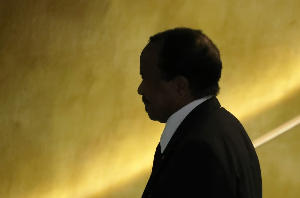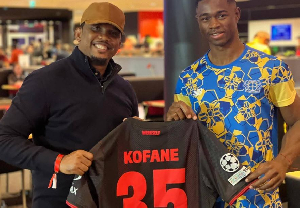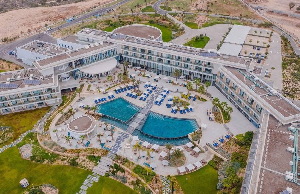“Sight is a function of the eyes; vision is a function of the heart” - Myles Munroe
The art of starting an enterprise or an endeavor in life with the end in mind is termed vision. Vision is the ability to see vividly the end of a thing or its destination at the beginning in your mind’s eye before it is realized.
This is one distinguishing factor between achievers and losers, leaders and followers, winners and whiners. It is absolutely ludicrous to think you can accomplish a noble task without seeing yourself completing it in your mind’s eye before you begin.
Woodrow T. Wilson, the 28th President of the United States of America, said, “No man that does not see visions will ever realize any high hope or undertake any high enterprise.”
The ability to perceive the future before it materializes is one of the most significant parts of vision fulfillment.
The principle of starting with the end in mind is also the law of creation and continues to govern everything we create or aspire to fulfill in life. Vision is visualizing your purpose in pictures. When you can clearly see the end product of a thing in pictures, you have a vision for that thing.
Note that no inventor, manufacturer, leader, or an individual who wants to fulfill his/her dream in life would dabble in or venture into a project without first starting with the end in mind. Vision is also the restraining force which keeps you from engaging in any unauthorized activity.
The one thing that can unite societies, people, families, workers, and groups adhesively together is not rules, laws, threats, oppression, or money but the clarity of vision. For example, why would you agree to travel on a bus, plane, or train with a group of unknowns and sometimes weirdoes? It is because the driver or pilot has declared the destination of the bus, train, or airplane; hence, there is a singleness of purpose.
Where there is a “starting with the end in mind,” people are most likely to tolerate each other since they all know they are heading to a specific or desired destination. As a result, the destination (vision) serves as a pacifier or a protective force against odds on the journey to vision fulfillment. Friedrich Wilhelm Nietzsche a 19th-century German philosopher, poet, composer and classical philologist professed that “He who has a why can endure any how.”
The life and philosophy of Nelson Rolihlahla Mandela, the first Black South African president, anti-apartheid activist, the leader of Umkhonto we Sizwe, and the armed wing of the African National Congress (ANC) epitomizes the restraining force of starting with the end in mind.
Born in Mvezo, a small village located in the district of Umtata, Mandela was affectionately known as Madiba (a tribal title for honor) by his close associates. He had a vision that Black South African people would one day overcome the atrocities, racism, oppression and inhumane treatment the White supremacists subjected them to; to a place where freedom reigns and where the whole of Africa would manage their own affairs.
He expressed this sentiment one day by quizzing, “If the United States of America or Britain is having elections, they do not ask for observers from Africa or from Asia. But when we have elections, they want observers.”
Though he had a promising future in Johannesburg, the capital of South Africa as a young lawyer, Mandela because of his stern belief in seeing his fellow Black South Africans and the entire African continent being free from foreign influence and oppression could not help but restrain himself to that pressing cause.
On 11 July 1963, after months of struggling with the White South African government and Police, and staging of anti-apartheid campaigns to make their voice and struggles heard across the world; a raid was undertaken by the White dominated South African Police on Lilieslief farm in Rivonia, near Johannesburg, which was being used by the Umkhonto we Sizwe or (MK), translated “Spear of the Nation” as headquarters.
The remaining leadership of the MK was arrested. Nelson Mandela together with the other ANC activists arrested was charged with over 200 counts of “sabotage, preparing for Guerrilla Warfare in South Africa and for preparing an armed invasion of South Africa.”
Mandela was one of the five (out of the ten defendants) at the Rivonia Trail to be given life sentences and sent to Robben Island. Mandela was confined behind bars on Robben Island where he spent eighteen out of his twenty-seven years in a penitentiary.
From 1964 to 1982, he was incarcerated at Robben Island Prison, off Cape Town; afterward, he was at Pollsmoor Prison, nearby on the mainland.
While in prison, Mandela because of his ability of seeing his people liberated from oppression continued to improve his repertoire of legal acumen by undertaking a Bachelor of Law degree correspondence program with the University of London and was diligently imparting his knowledge to the young generation prisoners in the Robben Island Prison.
Subsequently, in March 1982, Mandela was transferred from Robben Island to Pollsmoor Prison, along with other senior ANC leaders owing to the speculation that Mandela and his fellow ANC leaders were indoctrinating the new generation of young black activists imprisoned on Robben Island, the so-called “Mandela University.”
Nelson Mandela’s influence grew strong and wide even beyond the confines of Robben Island Prison that he became an icon and one of the most significant Black Leaders in South Africa and a potent symbol of resistance as the Anti-Apartheid Movement gathered momentum. On several occasions, he refused to sell out his belief in the freedom and destiny of the Black South African people by not compromising his political position to obtain his personal freedom.
Most times in order to truly influence your generation or the course of history with your vision, you have to sacrifice your personal freedom, resources, and sanctity for the good of the people. Martin Luther King, Jr. expressed the same sentiment by saying, “An individual has not started living until he can rise above the narrow confines of his individualistic concerns to the broader concerns of all humanity.”
Mandela was eventually given his personal freedom from behind bars on February 11, 1990, and immediately rolled up his sleeves and went back to work. In 1991, at the first national conference of the ANC held inside South Africa after the organization had been banned in 1960, Mandela was elected President of the ANC.
Finally, after over four decades of striving to attain liberty and the right to live life on their own terms as Black South Africans, South Africa's first multi-racial elections was approved by the then white government and held on 27 April 1994. The ANC won 62% of the votes in the election, and Mandela, as leader of the ANC, was inaugurated on 10 May 1994 as the country's first black President. The long awaiting quest to see Black South Africans take charge of their own affairs and destiny has partially manifested.
The gravity of your vision might not be on the same parity as Nelson Mandela’s but it is extremely important to understand that no worthy cause is achieved without starting with the end in mind and paying a price for it. Mandela saw his people having the freedom to control their own destiny far beyond the parameters of the eyesight into the hallway of the future, and with relentless persistence, hope, belief and corresponding actions to relay the present belief with the realization of the vision. Ultimately, he experienced what he saw at the beginning.
The most important element of a vision is not the seeing or the realization of it but the process of bringing it to fruition. In other words, the timeline between seeing and fulfilling the vision is the most crucial. American Inventor, Scientist, and Businessman Thomas Alva Edison held that, “Vision without execution is hallucination.” Bear in mind that most dreams and visions become stillbirths or stale in the transitional process from seeing to execution. The following are few suggestive steps to help you keep your vision alive:
• KNOW YOUR PURPOSE – It is of no use to have a vision without knowing your purpose but it is sad to say, this is the order of the day in this generation. Most people want to accomplish noble tasks in life but do not have the reason for their existence. Like a car without an engine so is a vision without purpose. Remember, vision is seeing your purpose in pictures. Thus, do not rush to get to the apex of the ladder of life just to realize that it is leaning on the wrong building!
• DOCUMENT YOUR VISION - Writing down your vision assists you to know your preferred destination in life and tells vision facilitators what direction you are taking in life. It also keeps you on track and helps to mind your own business.
Since your vision is written down, it would from time to time serve as a guiding map or the GPS (Global Positional System) of your journey to your destination in life. Furthermore, when you write down your vision, it guides you back to your original route anytime you veer off your track or if there is a detour or diversion on the way.
• CONCEPTUALIZE YOUR VISION - One of the most challenging aspects of vision is how to interpret or convert the idea into a compartmentalized form which is goal setting. Bill Copeland said “The trouble with not having a goal is that you can spend your life running up and down the field and never score.” Find a conducive atmosphere to put your vision and ideas into a mental structure or form that would be easy to comprehend. Put your vision into a simple concept that can be interpreted.
• EXECUTE - Most times it is in putting dreams into action that separates the boys from the men. American businessman , Jan Koum is of the conviction that, "a lot of times, people start out with a lot of good ideas, but then they don't execute. They lose the purity of their vision. You end up running around in circles." Resolve to give your ideas life by putting in place strategies to assist you in the execution.
• PERSEVERE - This is the art of being persistently consistent. If you really believe the vision, then you will dig in your heels and expect to be in it for the long haul. Determine to actualize what you have seen in your mind's eye. John Calvin Coolidge Jnr, the 30th President of the United States believed that “Nothing in the world can take the place of persistence. Talent will not; nothing is more common than unsuccessful men with talent. Genius will not; an unrewarded genius is almost a proverb. Education will not; the world is full of educated derelicts. Persistence and determination alone are omnipotent. The slogan, 'press on' has solved, and always will solve, the problems of the human race.”
Vision is our God-given map to our predetermined location in the journey of life. Hence, seek the roadmap to your life’s destination with vigor and if you are already on the pathway to your aspirations, I encourage you to persevere for your expectations will not be cut off. Discover Your Greatness!
Opinions of Friday, 8 May 2015
Auteur: Dr. Ignatius Otchere-Asamoah















